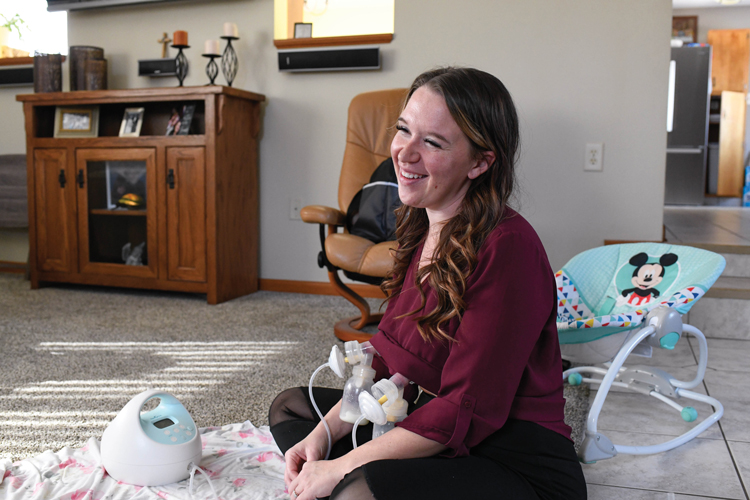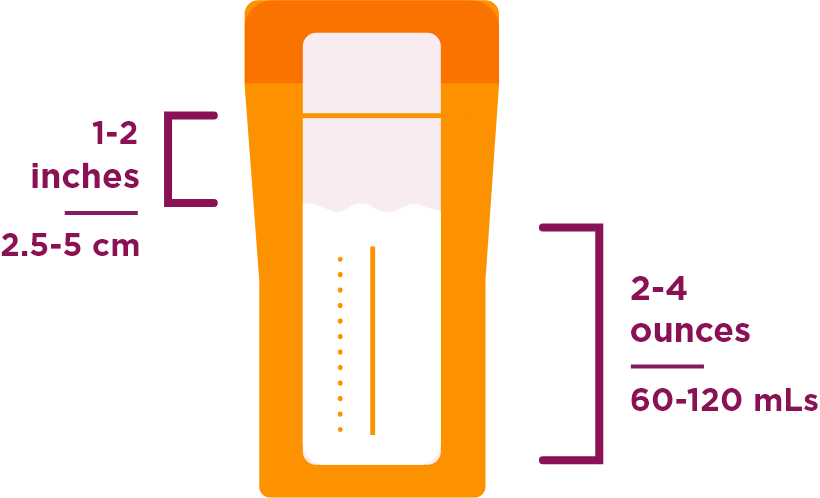Human Milk Storage Guidelines
Fresh Milk
Up to 4 Hours
Thawed Milk: 1-2 Hours
Countertop or Table:
77°F / 25°C or colder
Fresh Milk
Up to 4 Days
Refrigerator:
40°F / 4°C or colder
Fresh Milk
Within 6 Months is Best
(Up to 12 Months is Acceptable)
Never refreeze thawed milk
Freezer (with separate door):
0°F / -18°C or colder
Guidelines are for home use only and not for hospital use1
Collecting Human Milk
Before pumping or expressing milk, wash your hands well with soap and water.
Inspect all pump parts and tubing to make sure they are clean. Replace moldy tubing immediately.
Clean the counter or tabletop and outside of the pump, including any buttons or dials.

Storing Human Milk

Talk to your childcare provider about human milk storage.
Use any leftover milk from a feeding within two (2) hours after your baby is finished.
Human milk can be stored in human milk storage bags, glass containers, or hard plastic, BPA-free containers with tight fitting lids.
Avoid using disposable bottle liners or other plastic bags to store your milk. Please contact your local WIC clinic if you need milk storage bags.
Label the container with the date it was expressed. If you are giving the milk to a childcare provider, add your child’s name too.
Store expressed milk in the back of the freezer or refrigerator, not in the door. The temperature of the door varies due to opening and closing the door.
When traveling for short periods of time, such as to and from work or school, you can store pumped/expressed milk in an insulated cooler bag with frozen ice packs for up to 24 hours.
Freezing Human Milk
If you do not plan to use freshly pumped or refrigerated milk within four (4) days, freeze it right away.

Freeze milk in 2- to 4-ounce amounts to avoid waste.
Freeze storage bags flat to save space.
If a power loss happens, frozen milk is still good if crystals are still visible.
Thawing and Warming Human Milk
Use the oldest stored milk first. Practice FIFO (first in, first out).
While some babies may prefer warmed milk, human milk does not need to be warmed. It can be served at room temperature or cold.
Milk may be thawed in different ways:
1: In the refrigerator overnight
2: Under warm running water
3: In a container of warm water
Milk thawed with warm water should be used within one (1) hour after it is thawed or placed in the refrigerator.
Milk thawed in the refrigerator should be used within one (1) day (24 hours) after it is thawed.
If you decide to warm human milk, keep the container sealed. Place the sealed container into a bowl of warm water or hold it under warm, but not hot, running water. Do not heat directly on the stove or in the microwave. Test the milk temperature by dropping some on your wrist. It should be comfortably warm.
Gently swirl the milk (don’t shake it) to mix it, as it is normal for human milk to separate.
Do not microwave human milk. Microwaving breaks down nutrients and creates hot spots, which can burn your baby’s mouth.
Adapted from:
1. United States Department of Agriculture (USDA), Centers for Disease Control and Prevention (CDC),
and Department of Health and Human Services (HHS). (2018, July). Human Milk Storage Guidelines.
https://wicworks.fns.usda.gov/sites/default/files/media/document/Human_Milk_Storage_Guidelines.pdf
References:
Centers for Disease Control and Prevention (CDC). (2023, November 27). Breast Milk Storage and Preparation
https://www.cdc.gov/breastfeeding/breast-milk-preparation-and-storage/handling-breastmilk.html
Eglash, A., Simon, L., & The Academy of Breastfeeding Medicine. (2017). ABM Clinical protocol #8: Human milk storage information for home use for full-term infants. Breastfeeding Medicine, 12(7), 390-395.
https://doi.org/10.1089/bfm.2017.29047.aje